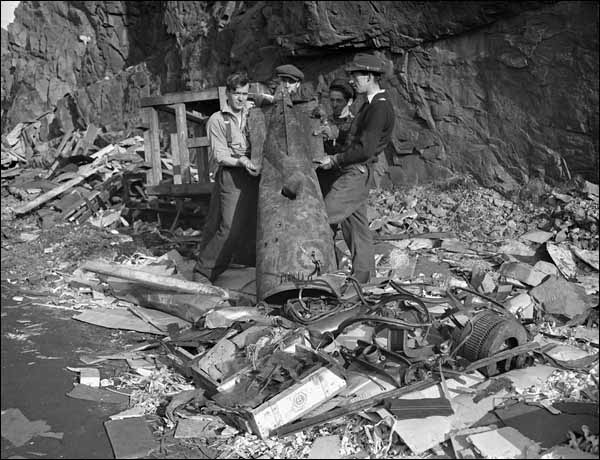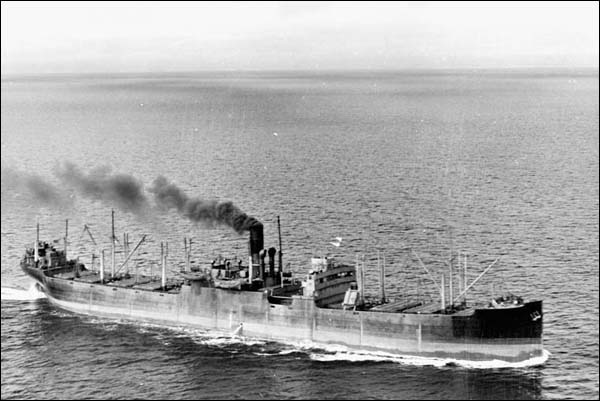Bell Island Sinkings
Bell Island is one of the few locations in North America that German forces directly attacked during the Second World War. U-boats raided the island twice in 1942, sinking four ore carriers and killing more than 60 men. The events highlighted how potentially vulnerable Newfoundland was to enemy attack, and it is perhaps not surprising that Canadian authorities, at the request of the Newfoundland Commission of Government, developed defensive plans in case the Germans tried to capture St. John's.

Newfoundland lay across the vital trans-Atlantic convoy routes that supported the Allied war effort. Allied ships navigated these paths to bring vital supplies to Britain, but were often attacked by roving packs of German U-boats. Certain areas were more prone to attack than others and these were designated “Dangerous Waters.” Newfoundland was surrounded by such waters and this was made more than apparent on September 5, 1942 when a U-boat sank the SS Lord Strathcona and SS Saganaga off Bell Island.
The Attacks
U-513, under Kapitän-Leutnant Rolf Ruggeberg, had arrived off Newfoundland in August and patrolled the Strait of Belle Isle. Having had no success, Ruggeberg decided to try his luck closer to St. John’s. Noticing steamers coming in and out of Conception Bay, he followed the small Evelyn B into the Bell Island anchorage on the surface after dark on September 4, and then spent the night on the bottom in 24 metres of water. The next morning, Ruggeberg rose to periscope depth and in quick succession, sank the Strathcona and Saganaga. Twenty nine men were killed in the attack, all from the Saganaga. Shortly thereafter, the U-513 escaped on the surface.
The next attack at Bell Island occurred almost exactly two months later, on November 2, 1942. This time, the U-513’s sister ship, U-518 under K/L Friedrich Wissmann, crept into Conception Bay, again under cover of darkness. Wissmann maneuvered the U-boat near the cliffs so as to escape detection, and kept so close that the deck crew could see car headlights traveling along the cliff edge above them.
After the attack in September, the Wabana anchorage had been fortified with guns and searchlights, and Wissmann decided to make a hit and run raid on the surface. He maneuvered through the narrow entrance between Bell Island and Little Bell Island, and saw two steamers silhouetted by the searchlight beams. He fired at the first, the Anna T, and missed. The torpedo went under the stern of the Flyingdale tied up at the Scotia Pier and blew up against the pier itself with a loud explosion. The defenses now alerted, Wissmann knew time was running out and quickly fired at the Rose Castle, sinking it with the loss of 28 men.
The Rose Castle and PLM 27
Interestingly enough, this was not the first time a U-boat had attacked the Rose Castle. The ship had been present in September when the U-513 sank the Saganaga and Lord Strathcona. Further, it had also been attacked in October by the U-69, which was on its way home after sinking the North Sydney to Port aux Basques ferry, the SS Caribou. At that time, the Rose Castle was lucky – the torpedo was a dud and even though it hit the steamer, it bounced off without exploding.

Regardless, the Rose Castle was not as fortunate during the November attack and went down quickly with the loss of most of its crew. Local divers discovered the body of one of the torpedoes that sank the Rose Castle in July 2000, and the O-ring that once held the warhead was presented to the mayor of Wabana.
Next in Wissmann’s sights was the PLM 27, a Free French ship. It went down quickly and with the loss of 12 crew members. Wissmann now did an about face and sailed out the way he had come, escaping undetected even though the corvette HMCS Drumheller and two Fairmile fast motor boats were patrolling Conception Bay.
Spy Suspected
Both the authorities and civilian population were in shock at the destruction and loss of life, which occurred so soon after the September attack and Caribou sinking in October. They began to believe that a spy was involved and suspicion fell on the captain of the PLM 27. He had not been on board the night his ship was sunk, and had sold his piano to a Bell Island resident just a few days before the attack. The fact that he was French and his country occupied by the Germans only contributed to his appearance of guilt – perhaps the Nazis had somehow coerced him into working for them. An investigation ensued, but officials concluded that neither the captain nor any other spy was involved. However, it was later discovered that a spy was indeed at the anchorage that night – on board U-518 was Werner von Janowski, an agent of Germany’s Abwehr intelligence service.
Successfully eluding the Royal Canadian Navy after the attack, the U-518 made its way along the south coast of Newfoundland and into the Gulf of St. Lawrence. Wissmann’s orders were to put von Janowski ashore at a secluded spot in the Baie des Chaleurs between New Brunswick and the Gaspé Peninsula. At 1:20 a.m. on November 9, von Janowski was landed not far from New Carlisle, Quebec. However, within 24 hours he was in the hands of the Royal Canadian Mounted Police having raised the suspicion of an innkeeper’s son with out-of-date money and Belgian matches. Von Janowski was eventually used as a double agent of dubious value.




